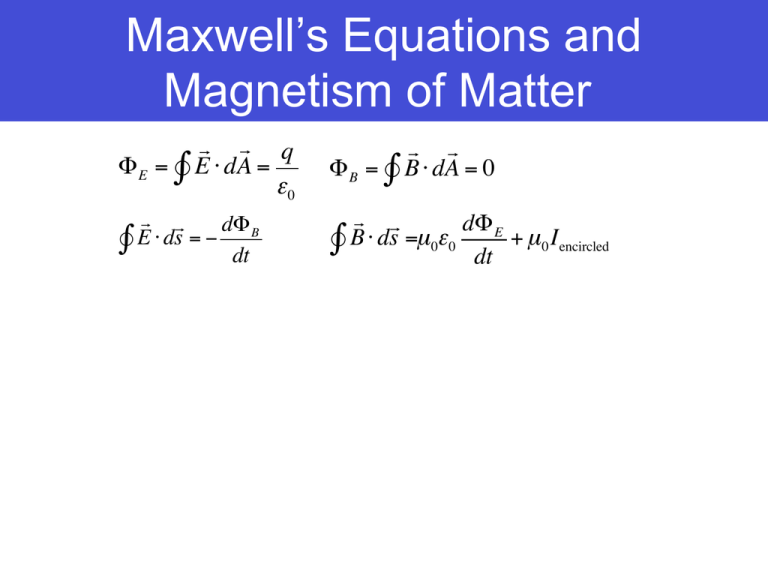Maxwell`s Equations and Magnetism of Matter
advertisement

Maxwell’s Equations and Magnetism of Matter ! ! q ΦE = " ∫ E ⋅ dA = ε 0 ! ! ΦB = " ∫ B ⋅ dA = 0 ! ! dΦ B E ⋅ d s = − "∫ dt ! ! dΦ E B ⋅ d s = µ ε + µ 0 I encircled 0 0 "∫ dt Gauss’ Law for Magnetic Particles The net magnetic flux ΦB through any closed Gaussian surface is zero. ! ! ΦB = " ∫ B ⋅ dA = 0 Gauss’ law for magnetic fields Compare with the Gauss’ Law for electrical charges: ! ! q ΦE = " ∫ E ⋅ dA = ε 0 Magnetic monopole does not exist (has not been found). Gauss’ Law for Magnetic Particles Gauss’ law for magnetic fields holds for structures even if the Gaussian surface does not enclose the entire structure. Gaussian surface II near the bar magnet encloses no poles, and we can easily conclude that the net magnetic flux through it is zero. For Gaussian surface I, it may seem to enclose only the north pole of the magnet because it encloses the label N and not the label S. However, magnetic field lines are loops and go from the south pole to the north pole inside the magnet. Induced Magnetic Fields: Ampere-Maxwell’s Law ! ! Ampere’s law "∫ B ⋅ ds =µ0 I encircled I encircled I encircled ? ! ! dΦ Maxwell’s law "∫ B ⋅ ds =µ0ε 0 E dt Ampere-Maxwell’s law ! ! dΦ E B ⋅ d s = µ ε + µ 0 I encircled 0 0 "∫ dt assume q is the charge on the plate, ! A$ from q = CV = #ε 0 & ⋅ Ed = ε 0 EA = ε 0Φ E " d% dq dΦ E I incircled = = ε0 ≡ I displacement dt dt the associated magnectic field follows Ampere's law B= µ 0 I displacement µ 0 I displacement r when r < R or B = 2π R 2 2π r Displacement Current Maxwell’s Equations Electricity & Magnetism, Maxwell’s Equations Charge q as source Current I as source Gauss’s Law Faraday’s Law Ampere’s Law Electric field E ! ! F = qE Magnetic field B Ampere-Maxwell Law ! ! ! F = qv × B Force on q in the field ! Force on qv or I in the filed Summarized in Maxwell equations Electricity & Magnetism, Maxwell’s Equations Charge q as source Current I as source ! ! q ΦE = " ∫ E ⋅ dA = ε 0 Electric field E ! ! F = qE ! ! "∫ B ⋅ ds =µ0 Iencircled ! ! dΦ E ∫" ⋅ ds = − dt B Magnetic field B ! ! dΦ E B ⋅ d s = µ ε + µ 0 I encircled 0 0 "∫ dt Force on q in the field ! ! ΦB = " B ⋅ dA = 0 ∫ ! ! ! F = qv × B ! Force on qv or I in the filed Summarized in Maxwell equations Magnetism of Matter There are three general types of magnetism: 1. Diamagnetism: Diamagnetic materials create an induced magnetic field in a direction opposite to an externally applied magnetic field, and are repelled by the applied magnetic field. 2. Paramagnetism: Paramagnetic materials are attracted by an externally applied magnetic field, and form internal, induced magnetic fields in the direction of the applied magnetic field. 3. Ferromagnetism is the basic mechanism by which certain materials (such as iron) form permanent magnets, or are attracted to magnets. These magnetisms are due to the fact that electrons in atoms have orbital magnetic dipole moments and spin magnetic dipole moments. The vector sum of all these magnetic dipole moments determines the magnetic characteristics of a certain material. Electron Spin Magnetic Dipole Moment An electron has an intrinsic angular momentum called its spin angular momentum (or just spin), S; associated with this spin is an intrinsic spin magnetic dipole moment, µs . (“intrinsic” means that S and µs are basic characteristics of an electron, like its mass and electric charge.) in which e is the elementary charge (1.60 x10-19 C) and m is the mass of an electron (9.11 1031 kg). Electron Spin Magnetic Dipole Moment The orientation energy for the electron, when Bext is the exterior magnetic field aligned along the z-axis. Electrons Orbital Magnetic Dipole Moment When it is in an atom, an electron has an additional angular momentum called its orbital angular momentum, Lorb . Associated with it is an orbital magnetic dipole moment, µorb ; the two are related by Only the component along any axis of the orbital angular momentum can be measured, and that component is quantized in which is ml called the orbital magnetic quantum number and “limit” refers to its largest allowed integer value. Similarly, only the component of the magnetic dipole moment of an electron along an axis can be measured, and that component is quantized. The orientation energy is: where the z axis is taken in the direction of Bext. Electrons Orbital Magnetic Dipole Moment The magnitude of the orbital magnetic dipole moment of the current loop shown is: Here A is the area enclosed by the loop. Since And since Therefore,




